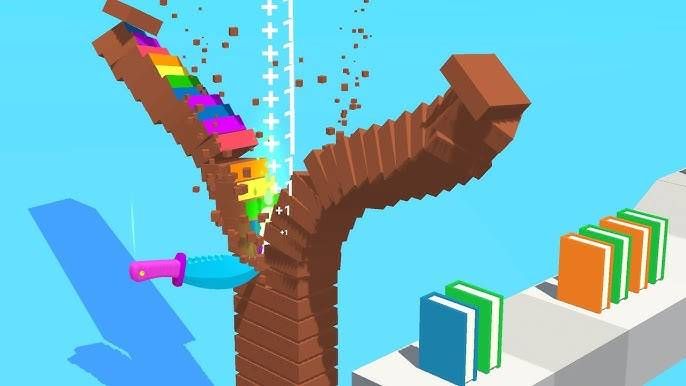

Welcome to Slice Master – The Ultimate One-Button Slicing Challenge. Think you’ve got what it takes to master the blade? Slice Master is not just another casual game—it’s a test of timing, reflexes, and precision. In this oddly satisfying, one-button challenge, your mission is simple: slice everything in sight (except for the pink traps). Whether you’re in for a chill break or chasing high scores, slicemasterunblocked.com will keep your fingers tapping and your focus razor-sharp.
Pac-Man, the iconic yellow character that has been gobbling up dots and running from ghosts for over four decades, has become more than just a video game. It’s a cultural phenomenon that has transcended generations, influencing pop culture, art, and even technology. In this article, we’ll explore the fascinating journey of Pac-Man, from its humble beginnings in Japanese arcades to its status as a global gaming legend.
Created by Toru Iwatani and released by Namco in 1980, Pac-Man quickly became a sensation in arcades around the world. The game’s simple yet addictive gameplay, coupled with its charming characters and catchy music, captivated players of all ages. But what made Pac-Man stand out from other games of its time, and how has it managed to remain relevant in the ever-evolving world of video games?
The story of Pac-Man’s creation is as intriguing as the game itself. Toru Iwatani, a young game designer at Namco, was inspired by the shape of a pizza with a Slice Master missing when he came up with the design for Pac-Man. He wanted to create a game that would appeal to a wider audience, including women, who were not typically targeted by the space shooter games that dominated arcades at the time.
Iwatani’s vision paid off. Pac-Man was an instant hit when it was released in Japan in 1980, and its popularity quickly spread to the United States and Europe. The game’s success was unprecedented, with over 100,000 units sold in the first year alone. Pac-Man fever had begun, and it showed no signs of slowing down.
At its core, Pac-Man’s gameplay is deceptively simple. Players control the titular character through a maze, eating dots and avoiding four colorful ghosts: Blinky, Pinky, Inky, and Clyde. Power pellets allow Pac-Man to turn the tables on the ghosts, temporarily making them vulnerable and edible. This easy-to-understand yet challenging concept was a major factor in the game’s widespread appeal.
The game’s difficulty curve was perfectly balanced, allowing new players to enjoy the experience while providing a significant challenge for those seeking to master it. The pursuit of high scores and the race to complete each maze before the ghosts caught up created a thrilling and addictive experience that kept players coming back for more.
As Pac-Man’s popularity soared, its influence began to extend far beyond the confines of the arcade. The game quickly became a cultural touchstone, inspiring merchandise, TV shows, music, and even food products. Pac-Man’s simple yet distinctive design made it easily recognizable and highly marketable.
In 1982, the animated series “Pac-Man” debuted on ABC, further cementing the character’s place in popular culture. The show ran for two seasons and introduced new characters and storylines to the Pac-Man universe. This expansion of the Pac-Man brand helped to keep the franchise relevant and appealing to a new generation of fans.
Pac-Man’s influence on music was perhaps most notably demonstrated by Buckner & Garcia’s 1982 hit single “Pac-Man Fever.” The song reached number 9 on the Billboard Hot 100 chart and spawned an entire album of video game-inspired tracks. This fusion of pop music and gaming culture was unprecedented at the time and highlighted Pac-Man’s broad appeal.
In the art world, Pac-Man has been the subject of numerous works, from street art to high-end gallery installations. The game’s distinctive imagery has been reinterpreted and reimagined by artists around the world, showcasing its enduring visual appeal and cultural significance.
As technology advanced, Pac-Man evolved along with it. The game made the transition from arcade cabinets to home consoles, starting with the Atari 2600 version in 1982. While this early port was criticized for its technical limitations, it still sold over 7 million copies, demonstrating the strong demand for home versions of arcade hits.
Subsequent releases on various platforms improved upon the original formula, introducing new gameplay elements, improved graphics, and even 3D environments. Games like “Ms. Pac-Man,” “Pac-Man World,” and “Pac-Man Championship Edition” kept the franchise fresh and appealing to new generations of gamers.
With the rise of smartphones and mobile gaming, Pac-Man found a new home on handheld devices. The simple, pick-up-and-play nature of the original game translated perfectly to mobile platforms, allowing players to enjoy Pac-Man on the go. Mobile versions of the game have been downloaded millions of times, introducing the classic character to yet another generation of players.
In recent years, augmented reality (AR) technology has given Pac-Man a new lease on life. Games like “Pac-Man Geo” use real-world maps as the game board, allowing players to navigate Pac-Man through familiar streets and landmarks. This innovative approach brings the classic gameplay into the real world, creating a unique and immersive experience.
Pac-Man’s impact on the video game industry cannot be overstated. The game’s success helped to establish video games as a mainstream form of entertainment, paving the way for the growth of the industry we see today. Many game designers cite Pac-Man as an inspiration, praising its elegant simplicity and addictive gameplay.
The character-driven nature of Pac-Man, with its distinct personalities for the ghosts and the titular hero, set a precedent for character design in video games. This approach influenced countless games that followed, from platformers to fighting games, where unique and memorable characters became a key element of game design.
What is it about Pac-Man that has allowed it to remain relevant for over four decades? Part of its enduring appeal lies in its simplicity. The game’s core mechanics are easy to understand but difficult to master, providing a perfect balance of accessibility and challenge. This timeless gameplay has allowed Pac-Man to transcend generations, appealing to both nostalgic older players and curious younger gamers.
Additionally, the character of Pac-Man himself has become an iconic symbol of video gaming as a whole. His simple, recognizable design has made him a mascot not just for his own franchise, but for the entire medium of video games. This iconic status has helped to keep Pac-Man in the public consciousness, even as new games and technologies have emerged.
As we look to the future, it’s clear that Pac-Man will continue to evolve and adapt to new technologies and gaming trends. Recent innovations like the AR-powered “Pac-Man Geo” show that there are still new ways to reimagine the classic formula. Virtual reality (VR) presents another exciting frontier for Pac-Man, with the potential for immersive, 360-degree maze experiences.
Bandai Namco, the current owners of the Pac-Man franchise, have expressed their commitment to keeping Pac-Man relevant for new generations of players. This includes not only new game releases but also collaborations with other popular franchises, appearances in films and TV shows, and continued merchandise licensing.